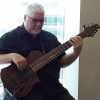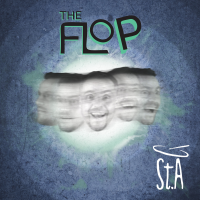Home » Jazz Musicians » Miroslav Vitous
Miroslav Vitous
Miroslav Vitous played music with his brother Alan and Jan Hammer while attending the Prague Conservatory, and played in a Dixieland band with trumpeter/singer Jiri Jerinek. Winning first prize in an international music competition in Vienna gave Miroslav the opportunity to study in the U.S., at Berklee College of Music. It was during this time that he was asked to play in Cannonball Adderley's group, but turned it down in order to complete his studies at Berklee. In the summer of 1967, Miroslav moved to New York to get involved in the vibrant music scene of the mid-sixties.
What many people may not know is that Miroslav was ranked as a top Olympic contender in free style swimming. He was on the international team going into the Olympic team from Munich. The discipline and strength required to excel in athletics transferred into his determination in music. He has admitted to the similarities of athletics to music, for example, when you hit a wall, and have to have the internal drive to keep going despite difficulties or setbacks. We can all imagine how difficult Miroslav must have had it - coming to the New York from a Communist country, by himself. His having made an impressive career both in his solo work as well as numerous collaborations, will perhaps be inspirational to other aspiring young musicians in Czechoslovakia, and elsewhere.
When Miroslav came to New York in 1967 he had the opportunity to play with a host of great musicians such as Art Farmer, Freddie Hubbard, Bob Brookmeyer, Stan Getz, Herbie Mann, Miles Davis and Chick Corea, to name a few. 1967 was also the year when America lost one of its jazz legends: John Coltrane. Coltrane had been a significant force in moving jazz to its free form, away from the hard bop, modal method of the fifties. Many performers during this time started integrating rock and free-form improvisations into their music. There were some rock influences, as well as experimentations with electronic instruments which were evident in many albums during this period. This is how fusion had its start, which may be broadly defined as the juxtaposition of numerous genres such as rock, funk, electronics and technology.
Miles Davis is considered to a very influential catalyst to the fusion style. From many of Miles' collaborators came the first wave of fusion musicians, such as Herbie Hancock, John McLaughlin, Chick Corea and Stanley Clark. One of the most celebrated fusion bands formed in 1971, was Weather Report. The musicians included saxophonist Wayne Shorter, pianist Joe Zawinul and Miroslav on bass. Other members included Airto Moirera and Alphonse Mouzon, who contributed to their first two albums, 'Weather Report' and 'I Sing the Body Electric'. Within these albums are evidence of experimentations with electronic effects on the bass as well as electric piano and organ. Miroslav played his bass upright, which he does to this day. The sounds eminating from the bass produced a horn-like vocal quality. These albums were characterized by very fluid arrangements and a highly improvised style.
Read moreTags
Steve Marcus, Miroslav Vitous, Sonny Sharrock, Daniel Humair: Green Line

by Joshua Weiner
Several decades into the jazz reissue boom, first on CD and now increasingly on vinyl, one might imagine the bottom of the barrel is being scraped, and that any newly rediscovered obscurities might at this point have been best left alone. Yet so vast are the archives of recorded jazz that diamonds remain in the mine, exemplified by Green Line, a beautiful document of a single session in Tokyo on September 11, 1970, credited jointly to saxophonist Steve Marcus, bassist ...
Continue ReadingLarry Coryell: Improvisations: Best of the Vanguard Years

by Josef Woodard
There have been many smoother operators in the world of jazz guitar than Larry Coryell, the brainy rough rider who was a natural-born fusioneer, in the best sense. There have been cleaner technicians on the instrument, with a more lucid sense of identity and careers that have followed a logical, rolling landscape. But not many have quite attained Coryell's strange, madly eclectic state of grace: into music he came, he saw and heard things not yet articulated, he conquered on ...
Continue ReadingAdam Pierończyk & Miroslav Vitous: Ad-Lib Orbits

by Dan McClenaghan
The duet performances on Ad-Lib Orbits feature the voices of two jazz generations. Adam Pieroncyzk, (b. 1970), the Polish saxophonist; and bassist Miroslav Vitous (b. 1947). Pieroncyzk has earned international acclaim for his homage to his countryman, Krzysztof Komeda on Komeda: The Innocent Sorcerer (Jazzwerkstatt Records, 2010) and on his odd and modernistic masterpiece, Monte Alban (Jazzsound, 2016). Vitous rose to top-level fame as a co-founder of the innovative group Weather Report in the 1970s. He has continued to push ...
Continue ReadingMiroslav Vitous: Ziljabu Nights - Live at Theater Gutersloh

by Glenn Astarita
This live album celebrates the 8th edition of the German record label's European Jazz Legends series, culminating in a book to be published in 2018. And each album is finalized with an interview track. So, it would make sense that eminent Czech bassist and co-founder of Weather Report, Miroslav Vitous would be included in the progression of this series. Other than drummer Roberto Gatto, the quintet comprises the same personnel who appeared on the successful Music of Weather Report (ECM, ...
Continue ReadingMiroslav Vitous: Music of Weather Report

by John Ephland
The music on bassist Miroslav Vitous' Music Of Weather Report is a fascinating document by an original member of that seminal group, formed in 1970. Revisiting music he helped to create as well as one tune that came after he left the group in 1974 (along with new music he wrote and one from original member Wayne Shorter's time with Miles Davis), one can enter the mind of this man's singular reinterpretations of such gems as “Seventh Arrow," but also ...
Continue ReadingMiroslav Vitous: Music of Weather Report

by Claudio Bonomi
Potremmo subito dire che questo album è un acquisto obbligato per tutti coloro che hanno amato, e continuano ad amare, i Weather Report e, soprattutto, la loro libertà musicale e il loro spirito avventuroso. Miroslav Vitous, contrabbassista di origine ceca, fu uno dei co-fondatori della band insieme a Joe Zawinul e a Wayne Shorter e fu artefice di una stagione radiosa, firmando album come I Sing the Body Electric (1972) o Mysterious Traveller (1974). Alphonso Johnson, lo rimpiazzò ...
Continue ReadingMiroslav Vitous: Music of Weather Report

by Mark Sullivan
Bassist Miroslav Vitous was a founding member of Weather Report, making him one of the architects of the highly improvisational approach taken by the original band. On his earlier album Remembering Weather Report (ECM, 2009) he evoked the spirit of the old band and its collective improvisational style (characterized by keyboardist Joe Zawinul as “No one solos, everyone solos"). This time he works directly with Weather Report repertoire (plus a few brief new compositions). Both the instrumentation and the stylistic ...
Continue ReadingMiroslav Vitous - Remembering Weather Report

Source:
ECM Records
Remembering Weather Report - a new album from bassist Miroslav Vitous was released on July 7th. According to Nate Chinen of the New York Times, Vitous “brings a rigorous sense of proportion to this album, exploring free-form terrain with the stateliest kind of boldness" and he calls it a “severely elegant album." Vitous was one of the founders of Weather Report and helped to shape its early (and revolutionary) mix of enigmatic, free-flowing compositions and high-level improvisational dialogues, in which ...
read more
Legendary Bassist Miroslav Vitous Interviewed at AAJ

Source:
All About Jazz
You can't ask for a more interesting interview subject than Miroslav Vitous, but anyone in search of self-deprecation or false modesty would be best advised to seek elsewhere. Simply put, Miroslav Vitous believes in Miroslav Vitous; he believes--no, knows--that his work is important, and he will not waste a moment pretending otherwise.
In addition to being a founding member of fusion supergroup Weather Report, alongside Joe Zawinul and Wayne Shorter, Vitous produced some marvelous recordings under his own name throughout ...
read more
The Jazz Session #24: Miroslav Vitous

Source:
All About Jazz
On the new episode of The Jazz Session, Jason Crane interviews bassist Miroslav Vitous. Vitous came to the U.S. in 1966, and quickly became part of the New York jazz scene. He was a founding member of Weather Report along with Wayne Shorter and Joe Zawinul. Vitous played on the landmark trio session Now He Sings, Now He Sobs (Blue Note, 1968) with Chick Corea and Roy Haynes. Vitous's new album is Universal Syncopations II (ECM, 2007), the sequel to ...
read more





























_with_Skip_Mcdonald_(Right)_23_n.jpg)














